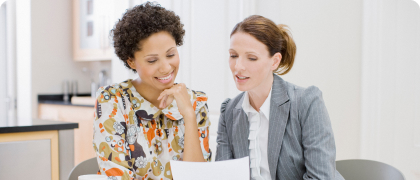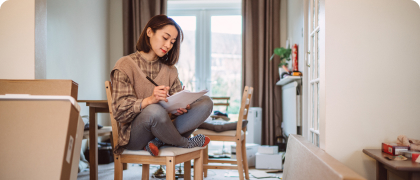Published: 6 September 2024
There's plenty to do once you've moved into a new home, but sometimes it’s hard to know where to start. That’s why we've put together a 7-step guide to settling in for all you home movers - from the first night to the finishing touches.
1. Unpack the essential items
On your first night in your new home, you'll only need the essentials. So prioritise your unpacking. Make a list of the things you’ll need for your first night and stick to it.
To make life easier, pack the items on your list into one box, so it’s all in one place. No one wants to have to dig to the bottom of every box to find what they need.
2. Help your pets feel at home
Moving home can be a tricky time for pets, too. Different animals will have different needs, but the general advice remains the same for all pets. Put them in a quiet room away from all the commotion, with plenty of food, water and entertainment. Check on them regularly throughout the day, and give them lots of cuddles!
If you have a dog or a cat, you also need to make sure they can’t escape the room. In unfamiliar surroundings, some pets will try to get out and go back to your old home.
If your pet is microchipped, remember to update the address and contact details.
3. Sort out your utilities
Before you leave your old home, record the readings on your gas and electricity meters. Then call your energy provider, let them know you’re moving and tell them your final readings.
When you move into your new home, take meter readings as soon as you get a spare minute. Next, call the company that currently provides energy to the property and let them know you’ve moved in. This way, you won’t end up paying for the energy used by the old owner. If you’re not sure who supplies the energy, call the meter helpline on 0870 608 1524.
If you haven’t sorted out a new tariff, you’ll probably be added automatically to the standard tariff, which is usually the most expensive. Take some time to compare energy suppliers; it’s a quick way to lower your monthly outgoings.
4. Change your address and set up direct debits
When you move out of your old home, you should leave a forwarding address for the next occupant. You can also register with Royal Mail’s redirection service.
Once you’ve moved, there are (unfortunately) an awful lot of people you need to inform. It’s not the most thrilling part of home ownership, but it’s something you can get out of the way without too much fuss. You’ll just need to add this task to your moving home checklist.
First things first, update your bank or building society. They’ll change the billing address on your account, which will make life easier going forward.
Next, sort out all the things that involve standing orders or direct debits. This might include:
- Gas and electricity suppliers
- Water suppliers
- Council tax
- Insurance
- TV Licensing
- Internet provider
- Mobile phone provider
- Recurring charity donations
If you’re staying in the same job, or your children are staying at the same school, you should let them know as soon as possible.
You’ll also need to inform:
- DVLA
- HMRC
- Student loans
- Loyalty card companies
- Doctor
- Dentist
- Optician
- Vet
- Electoral commission
- Subscriptions
5. Get to know the local area
Once you’re feeling a bit more settled in your new home, take some time to get to know the local area. Find and register with your nearest doctor and dentist, look for the police and fire stations, and find out when the rubbish is collected.
Next, research public transport links. Find the nearest bus stop, check which buses go where, and look up the nearest train station.
And don’t forget to look out for leisure activities. Where are the nearest restaurants and bars? If you have children, are there any after-school clubs they can join?
6. Make your home secure
The first – and easiest – step to making your home more secure is to change the locks. You can’t know how many people the previous owner gave keys to, and it’s better to be safe than sorry.
Once you’ve done that, have a look around your new home and see if there are any areas that could be made more secure.
Some of the most important parts of a house, in terms of security, are:
Windows
All your windows should have locks on them. Installing double glazing (if you don’t already have it) will also make them more secure
Doors
Solid wood or metal doors are more secure than hollow wood doors. They’re a bit more expensive, but the added security is worth it. All of your external doors should be strong, including conservatory doors, garage doors and gates.
Fences
A good strong fence can help deter any would-be thieves. 6ft is generally considered a suitable height. You could also consider buying a security system and installing outdoor lights, if you don't already have them.
7. Make your home safe for the whole family
Most of us are familiar with the basics, like smoke alarms and carbon monoxide detectors. But if you have children, creating a safe environment can be a much bigger challenge.
So, as soon as you can, take some time to go round each room and look for anything that could be unsafe.
Falls are the most common way that children get hurt, so replace any worn or frayed carpets throughout the house, and put non-slip mats under rugs. You can also attach corner protectors to furniture, so your children will be less likely to hurt themselves if they do fall.
Another good way to make your home safe is to add childproof latches to cupboard doors, and put stops on removable drawers so they don't fall out. It's also a good idea to add a gate to rooms (such as the kitchen) where you don't want your little explorers to venture.
To keep your windows safe, fit them with childproof latches so that they only open a few inches.
Speaking of safety, don’t forget to take out home insurance to protect everything as well as everyone!
Just follow these 7 steps and you'll be settled into your new home in no time, as well as reading through more of our helpful home buying suggestions.
This article is intended as a summary only and shouldn’t be confused for legal advice given by Leeds Building Society. Please don’t use this guide as advice, you’ll need to make your own decisions. If you have any further questions or queries, we recommend seeking legal and/or financial advice.



